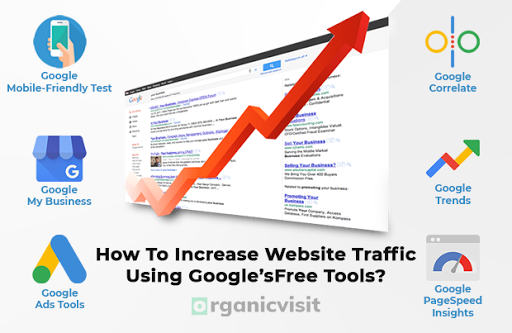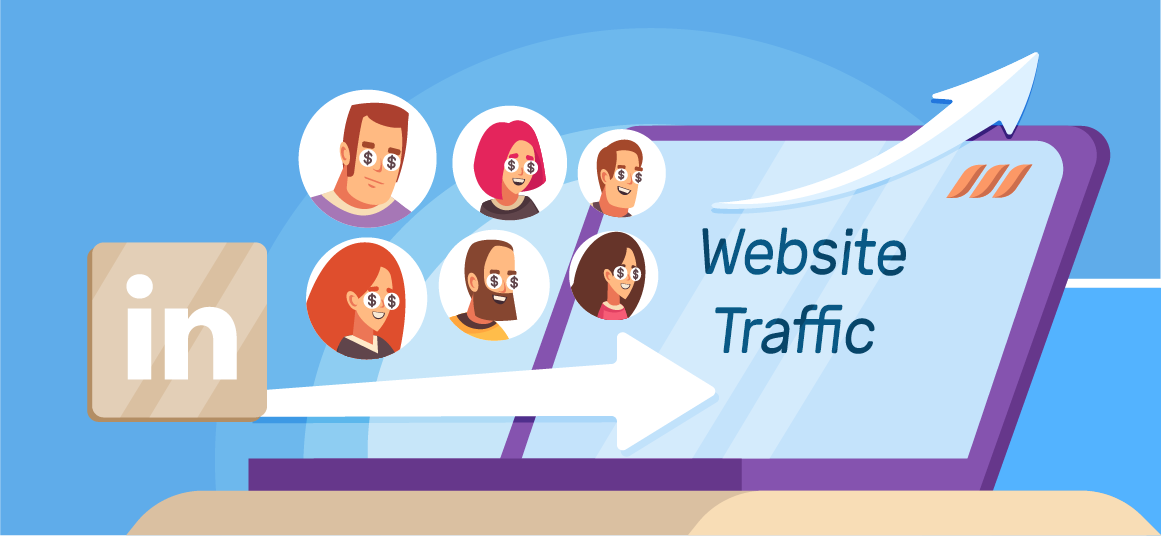Are you struggling to boost your website traffic? Ads can be a powerful tool.
Increasing website traffic with ads is not just about creating campaigns; it’s about strategically leveraging them to capture genuine leads. Ads2List is a revolutionary software that helps you do just that by capturing leads directly from Google and YouTube ads, without needing prospects to fill out forms. This method not only speeds up the lead generation process but also ensures accuracy and compliance with data protection regulations. In this blog post, we will explore how you can increase website traffic using ads effectively and how Ads2List can simplify this process for you. Ready to dive in and discover the potential of ads for boosting your site traffic? Let’s get started! Check out Ads2List here.

Credit: www.linkedin.com
Introduction To Increasing Website Traffic With Ads
Using ads can effectively boost your website traffic. Targeted advertisements attract more visitors, increasing engagement and visibility.
Increasing website traffic is essential for online success. One effective way to achieve this is through advertising. Ads can drive targeted visitors to your site, leading to more engagement and potential conversions. This section will cover the importance of website traffic and provide an overview of advertising strategies.The Importance Of Website Traffic
Website traffic is crucial for several reasons:- Visibility: More traffic means more people see your content.
- Engagement: Higher traffic increases the chances of user interaction.
- Conversions: More visitors can lead to more sales or leads.
- SEO Benefits: High traffic can improve your search engine rankings.
Overview Of Advertising Strategies
There are various advertising strategies to boost website traffic:| Strategy | Description |
|---|---|
| Google Ads | Use Google’s extensive network to target specific keywords and audiences. |
| Social Media Ads | Advertise on platforms like Facebook, Instagram, and Twitter to reach a broader audience. |
| Display Ads | Place banner ads on relevant websites to attract visitors. |
| Native Ads | Use ads that blend seamlessly with website content to engage users. |
- Accurate and fast lead processing using Google Ad’s Webhook technology and APIs.
- Directly sends leads to your autoresponder with no forms needed.
- Single-click signup for ease of use.
- Welcome emails with access details.
- Compliance with GDPR and PECR.
Additional Tips
To maximize your ad effectiveness:- Create compelling ad copy and visuals.
- Target the right audience based on demographics and interests.
- Monitor and adjust your campaigns for better performance.
Understanding Different Types Of Ads
Increasing website traffic with ads is a powerful strategy. Different types of ads cater to different audiences and purposes. Understanding them is crucial for maximizing your ad spend. Here, we delve into various ad types to help you make an informed decision.
Search Engine Ads: How They Work
Search engine ads appear at the top of search results pages. They target users who are actively searching for related keywords.
- Pay-per-click (PPC): Advertisers pay each time someone clicks their ad.
- Cost-per-impression (CPM): Advertisers pay for every 1,000 impressions.
These ads use keywords to match user queries. This intent-based targeting makes them highly effective.
Display Ads: Capturing Audience Attention
Display ads are visual and appear on websites within a network. They can be images, videos, or banners.
They are useful for:
- Brand awareness
- Remarketing
Display ads capture attention with engaging visuals. They are less direct but effective for visibility and recall.
Social Media Ads: Engaging Your Audience
Social media ads appear on platforms like Facebook, Instagram, and LinkedIn. They target users based on demographics and interests.
- Sponsored posts: Blended into user feeds, making them less intrusive.
- Story ads: Short-lived but highly engaging, perfect for limited-time offers.
These ads foster direct engagement, encouraging likes, shares, and comments.
Native Ads: Blending With Content
Native ads match the look and feel of the platform they appear on. They blend with the surrounding content, offering a non-disruptive experience.
Benefits include:
- Higher engagement rates
- Better user experience
Native ads are less likely to be ignored, making them effective for content marketing.
Key Features Of Successful Ad Campaigns
Creating a successful ad campaign involves multiple factors. These factors ensure that your ads reach the right audience, engage them effectively, and drive them to take action. Here are some key features to consider:
Targeting The Right Audience
Accurate audience targeting is crucial for any ad campaign. Identify your ideal customer by considering demographics, interests, and online behavior. Use platforms like Google and YouTube to refine your audience based on these criteria. With Ads2List, you can capture leads directly from Google ads, ensuring you reach the right people.
- Use demographic data to target specific age groups and locations.
- Leverage interest-based targeting to reach users interested in your niche.
- Implement retargeting strategies to re-engage previous visitors.
Compelling Ad Copy And Visuals
Engaging ad copy and visuals grab attention. Write clear and concise headlines that convey your message quickly. Use high-quality images or videos that resonate with your audience. Ensure that your ad copy is compelling and includes a strong value proposition.
- Use high-resolution images or videos.
- Craft headlines that highlight benefits.
- Include a clear and concise call-to-action.
Effective Call-to-actions (ctas)
A well-crafted CTA directs users to take the desired action. Make your CTAs clear and compelling. Use action-oriented language that encourages users to click. Ensure that your CTA stands out visually and is easy to find.
- Use phrases like “Sign Up Now” or “Get Started Today”.
- Place your CTA button where it is easily visible.
- Test different CTAs to see which ones perform best.
Optimizing Landing Pages
The landing page is where the user lands after clicking your ad. Ensure it matches the ad’s message and provides a seamless user experience. The landing page should load quickly, be easy to navigate, and contain a clear CTA.
| Feature | Importance |
|---|---|
| Consistent Messaging | Ensures users find what they expect. |
| Fast Load Time | Reduces bounce rate and improves user experience. |
| Clear CTA | Guides users to take the next step. |
By focusing on these key features, you can create ad campaigns that effectively increase website traffic and generate leads. Utilizing tools like Ads2List can further enhance your efforts by streamlining the lead capture process and ensuring accurate data collection.
Pricing And Affordability Of Ad Campaigns
Understanding the pricing and affordability of ad campaigns is crucial for maximizing the effectiveness of your marketing efforts. With the right strategies, you can ensure a significant return on investment (ROI) while keeping costs manageable. Let’s break down the key aspects of budgeting for ad spend, comparing Cost-Per-Click (CPC) vs. Cost-Per-Impression (CPM), and ROI considerations.
Budgeting For Ad Spend
When planning your ad campaigns, setting a clear budget is essential. Here are some tips to help you allocate your ad spend effectively:
- Determine your overall marketing budget.
- Allocate a specific portion to online ads.
- Consider the duration and goals of your campaign.
- Monitor and adjust your spending as needed.
Using tools like Ads2List, you can streamline your lead capturing process, reducing costs associated with manual data entry and form completions. This efficiency can help you stay within budget while maximizing lead generation.
Cost-per-click (cpc) Vs. Cost-per-impression (cpm)
Two common pricing models for ad campaigns are Cost-Per-Click (CPC) and Cost-Per-Impression (CPM). Understanding the differences can help you choose the best model for your needs:
| Model | Description | Best For |
|---|---|---|
| CPC | Pay for each click on your ad. | Driving traffic to your website. |
| CPM | Pay for every 1,000 impressions of your ad. | Brand awareness and visibility. |
Using Ads2List, you can capture leads directly from clicks on Google and YouTube ads, making the CPC model particularly effective for your campaigns.
Return On Investment (roi) Considerations
Maximizing your ROI involves careful planning and analysis. Here are some considerations:
- Track conversions: Monitor how many leads convert to sales.
- Analyze performance: Use tools to analyze ad performance and make data-driven decisions.
- Adjust strategies: Continuously refine your ad strategies based on performance data.
With Ads2List, you can ensure that your ad campaigns are not only cost-effective but also yield high-quality leads, increasing your overall ROI.
Pros And Cons Of Using Ads To Increase Website Traffic
Using ads to increase website traffic can be an effective strategy. It allows businesses to reach a wider audience quickly. But, it’s not without its challenges. In this section, we will explore the advantages and limitations of paid advertising. We will also discuss how to balance ads with organic traffic strategies.
Advantages Of Paid Advertising
Paid advertising offers several benefits:
- Immediate Results: Ads drive traffic to your website quickly.
- Targeted Audience: Ads allow you to target specific demographics.
- Measurable Performance: Ad platforms provide detailed analytics and insights.
- Increased Visibility: Ads boost brand awareness in competitive markets.
- Scalability: Ad campaigns can be scaled up or down based on budget and goals.
Challenges And Limitations
Despite the benefits, there are challenges to consider:
- Cost: Paid ads can be expensive, especially for competitive keywords.
- Ad Fatigue: Users may ignore ads if they see them too often.
- Click Fraud: Competitors or bots may click on your ads, wasting your budget.
- Temporary Traffic: Traffic from ads stops when the campaign ends.
Balancing Ads With Organic Traffic Strategies
Combining ads with organic strategies is crucial for long-term success. Here’s how to balance both:
- Invest in SEO: Optimize your website for search engines to attract organic traffic.
- Create Quality Content: Publish valuable content to engage visitors and improve rankings.
- Use Social Media: Leverage social media platforms to drive traffic organically.
- Monitor Performance: Regularly review analytics to adjust your strategies.
- Allocate Budget Wisely: Distribute your budget between ads and organic efforts.
Paid ads can boost traffic quickly, but combining them with organic strategies ensures sustainable growth.

Credit: www.website.com
Recommendations For Ideal Users And Scenarios
Advertising can significantly boost website traffic, but different businesses benefit from different strategies. Below are recommendations tailored to various types of users and scenarios for maximizing traffic with ads.
Best Practices For Small Businesses
Small businesses often operate with limited budgets and resources, making it crucial to get the most out of every ad dollar spent. Here are some best practices:
- Target Local Audience: Use geo-targeting to focus your ads on a local audience. This ensures your ads reach people who are more likely to visit your store or use your services.
- Utilize Google My Business: Optimize your Google My Business listing to appear in local search results. This complements your ad campaigns and increases visibility.
- Leverage Social Media Ads: Platforms like Facebook and Instagram offer cost-effective advertising options that can reach a targeted audience.
Strategies For E-commerce Websites
E-commerce websites require a strategic approach to drive traffic and convert visitors into customers. Consider the following strategies:
- Retargeting Campaigns: Use retargeting ads to reach visitors who have previously visited your site but did not make a purchase.
- Google Shopping Ads: Utilize Google Shopping ads to showcase your products directly in search results, making it easier for potential customers to find and buy your products.
- Email Capture: Implement tools like Ads2List to capture leads from ads and send automated welcome emails, increasing the chances of conversions.
Approaches For Content-driven Sites
Content-driven websites, such as blogs and news sites, need to focus on attracting and retaining readers. Here are some effective approaches:
- Sponsored Content: Partner with brands to create sponsored content that aligns with your audience’s interests.
- Promote Evergreen Content: Use ads to promote evergreen content that remains relevant over time, ensuring a steady stream of traffic.
- Social Media Boosts: Boost your top-performing posts on social media to reach a wider audience and drive traffic to your site.
Tips For Local Businesses
Local businesses can greatly benefit from targeted advertising to drive foot traffic and local engagement. Here are some tips:
- Local SEO: Optimize your website for local search terms to appear in local search results.
- Community Engagement: Advertise local events or promotions to engage with your community and attract visitors.
- Google Ads Extensions: Use ad extensions like location and call buttons to make it easier for potential customers to find and contact you.
Measuring And Analyzing Ad Campaign Success
To increase website traffic effectively, understanding the performance of your ad campaigns is crucial. Measuring and analyzing ad campaign success enables you to optimize your strategies, ensuring you get the best return on investment (ROI). This section will guide you through the key metrics to track, the tools for monitoring ad performance, and how to adjust your strategies based on data.
Key Metrics To Track
Tracking the right metrics provides a clear picture of your ad campaign’s effectiveness. Here are some essential metrics to monitor:
- Click-Through Rate (CTR): Measures the percentage of people who clicked on your ad after seeing it.
- Conversion Rate: Indicates the percentage of visitors who completed a desired action, such as signing up or making a purchase.
- Cost Per Click (CPC): Shows the average cost for each click on your ad.
- Return on Ad Spend (ROAS): Calculates the revenue generated for every dollar spent on ads.
- Impressions: The number of times your ad was displayed.
Tools For Monitoring Ad Performance
Using the right tools is essential for effective ad performance monitoring. Here are some popular tools that can help:
- Google Analytics: Tracks website traffic and user behavior, providing insights into ad performance.
- Facebook Ads Manager: Monitors the performance of your Facebook ad campaigns.
- Google Ads: Provides detailed metrics on your Google ad campaigns.
- Ads2List: Captures leads directly from Google and YouTube ads into autoresponders, ensuring accurate data collection.
Adjusting Strategies Based On Data
Analyzing data helps refine your ad strategies. Follow these steps:
- Identify Trends: Look for patterns in your data to understand what works best.
- Optimize Ads: Adjust your ad copy, targeting, and bidding strategies based on performance data.
- Test Variations: Use A/B testing to compare different versions of your ads and determine the most effective one.
- Review Frequently: Regularly review your campaign data to keep your strategies up to date.
Incorporating these practices ensures your ad campaigns are always optimized for the best performance, leading to increased website traffic and better ROI.
Conclusion: Maximizing Website Traffic With Ads
Increasing website traffic through ads can be highly effective when done right. By leveraging the power of targeted advertising, you can reach a broader audience and convert more visitors into leads or customers.
Summary Of Proven Strategies
Several strategies have proven to be successful in maximizing website traffic with ads:
- Targeted Campaigns: Focus on specific demographics to ensure your ads reach the right audience.
- Using Google Ads: Utilize Google’s extensive network to capture leads through lead-gen ads.
- Single-Click Signup: Implement single-click signups to reduce user resistance.
- Accurate Lead Capturing: Use tools like Ads2List to directly send leads from ads to your autoresponder.
- Welcome Emails: Send automatic welcome emails to engage new subscribers immediately.
Future Trends In Online Advertising
Stay ahead of the curve by keeping an eye on emerging trends in online advertising:
- AI and Machine Learning: These technologies will continue to improve ad targeting and personalization.
- Video Ads: The popularity of video content will drive more businesses to invest in video ads.
- Interactive Content: Ads with interactive elements will engage users better and increase conversion rates.
- Privacy Regulations: Compliance with GDPR and other data protection laws will become even more critical.
Final Tips For Continued Success
To ensure ongoing success with your advertising efforts, consider the following tips:
- Monitor Performance: Regularly review your ad performance to identify what works and what doesn’t.
- Optimize Campaigns: Continuously optimize your campaigns based on performance data.
- Stay Updated: Keep up with the latest advertising trends and tools.
- Invest in Training: Take advantage of training resources to improve your ad strategy.
- Engage with Leads: Use tools like Ads2List to efficiently capture and engage with leads.
By following these strategies and staying informed about future trends, you can maximize your website traffic with ads effectively.

Credit: dripify.io
Frequently Asked Questions
How Do Ads Increase Website Traffic?
Ads increase website traffic by targeting specific audiences. They attract visitors who are interested in your content. Effective ads can drive significant traffic quickly.
What Types Of Ads Are Best For Traffic?
Display ads, social media ads, and search engine ads are effective. They reach a broad audience and can be targeted precisely.
Are Paid Ads Worth The Investment?
Yes, paid ads can be worth the investment. They provide immediate visibility and traffic, offering a quick return on investment.
How Can I Measure Ad Performance?
You can measure ad performance using analytics tools. Track metrics like click-through rates, conversions, and traffic sources to gauge success.
Conclusion
Ads can significantly boost website traffic and lead generation. Ads2List simplifies this process, making it efficient and user-friendly. With Ads2List, capture leads directly from Google and YouTube ads without forms. Enjoy fast, accurate lead processing and easy autoresponder integration. Ready to increase your website traffic? Check out Ads2List and see the difference it makes. Learn more about Ads2List here.

I am a passionate digital marketer with a strong expertise in SEO and article writing. With years of experience in crafting compelling content and optimizing it for search engines, I help businesses enhance their online visibility and drive organic traffic. Whether it’s creating engaging blog posts or implementing effective SEO strategies, I am dedicated to delivering results that make an impact.
